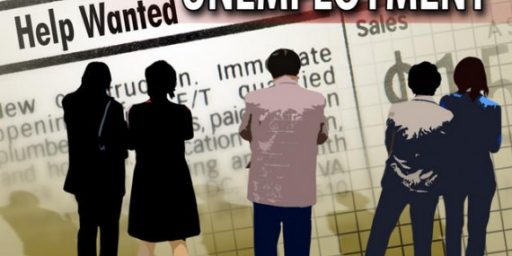Not the Great Depression (Updated)
Daniel Gross makes the case that I’ve been making for weeks, supplying hard numbers where I’ve relied on common sense, that the current mess isn’t comparable to the Great Depression:
Both got going when financial crisis led to a reduction in consumer demand. But the two phenomena differ substantially. Instead of workers with 5 o’clock shadows asking, “Brother, can you spare a dime?” we have clean-shaven financial-services executives asking congressmen if they can spare $100 billion. More substantively, the economic trauma the nation suffered in the 1930s makes today’s woes look like a flesh wound.
“By the afternoon of March 3, scarcely a bank in the country was open to do business,” FDR said in his March 12, 1933, fireside chat (now available on a very cool podcast at the Federal Deposit Insurance Corp.’s Web site). In 1933, some 4,000 commercial banks failed, causing depositors to take huge losses. (There was no FDIC back then.) The recession that started in August 1929 lasted for a grinding 43 months, during which unemployment soared to 25 percent and national income was cut in half. By contrast, through mid-November 2008, only 19 banks had failed. The Federal Reserve last week said it expects unemployment to top out at 7.6 percent in 2009. Economists surveyed by the Philadelphia Federal Reserve Bank believe the recession, which started in April 2008, will be over by next summer. (Of course, back in January the same guys forecast that the economy would grow nicely in 2008 and 2009.) But don’t take it from me. Take it from this year’s Nobel laureate in economics. “The world economy is not in depression,” Paul Krugman writes in his just-reissued book The Return of Depression Economics. “It probably won’t fall into depression, despite the magnitude of the current crisis (although I wish I was completely sure about that).”
Krugman, though, says there’s a very important parallel: “the collapse of policy certainties. In particular, the Fed’s sudden impotence — its inability to cut rates any more, because they’re essentially zero — is a very real parallel with the Depression, and necessitates drastic responses.”
We no doubt have a systemic crisis unlike any we’ve seen in my lifetime and need massive reform to bring the rules of the game — which were written in 1944 — into alignment with modern realities.
At the same time, though, the macroeconomy is in better shape than it was in the 1970s. Recall Jimmy Carter’s “Misery Index,” which was obtained by adding unemployment and inflation. It stood at 13.57% in the summer of 1976 and had climbed to 21.98% by the time Carter was running for re-election in the summer of 1980. It’s currently at 11.3%. (I’ve often seen the Index include the prime interest rate. We’re in even better shape, comparatively, if we do that.)
This isn’t to say we shouldn’t be concerned, much less that we shouldn’t make policy responses. But we shouldn’t panic, either.
UPDATE (Dave Schuler)
This piece caught my eye this morning, too, but I’m afraid it elicited a somewhat less temperate response from me than it did from James. Much of my reactions were due to a train of thought somewhat along these lines:
We no doubt have a systemic crisis unlike any we’ve seen in my lifetime and need massive reform to bring the rules of the game — which were written in 1944 — into alignment with modern realities.
and which our colleague, Steve Verdon, might well second. Where is the moral hazard? What possible disincentives can be provided when the incentives for malfeasance are so high? When you have a personal fortune in the tens or hundreds of billions what does a fine in the millions mean? Social stigma is almost absent as a motivator in our society—as long as you’ve got money people will fawn over you no matter how you got it.
Arnold Kling has suggested increased criminalization of malfeasance in the financial sector:
I look at this crisis as a mountain of regulatory arbitrage. The brightest financial minds focused on ways to pile risks onto banks without regulators being able to see it.
If we are going to have a regulated, guaranteed financial sector (such as banks with insured deposits), then that sort of behavior needs to be criminalized. I would suggest creating a statute that makes conspiracy to mislead bank regulators a crime punishable be long imprisonment. Define the terms in the statute in such a way so as to make prosecution easy—don’t create standards of proof so difficult that a good lawyer can get a guilty defendant off. Such a statute would really, really, raise the risk of setting up schemes to privatize profits while socializing losses.
Again, when the prospective rewards are no enormous would the highly unlikely threat of detection, prosecution, and brief incarceration really be a deterrent?
More thoughts at The Glittering Eye.






Trends are bad, and so I’d be slow to make any call based on what unemployment (or the misery index) “is.”
My first concern, the first bad trend, is the explosion of Depression and New Deal discussion. (Actually “‘new deal'” has a weird cyclical trend. On the other hand “depression economics” has a recent spike.)
My second concern is more fundamental, that critical parts of the economy are not finding support. We’re told that good bonds don’t have buyers. We’re told that good loans are not being rolled over.
.. as consumer spending falls and unemployment rises.
I certainly wouldn’t call this a done deal. I wouldn’t call it another Great Depression – but I sort of worry that connected insiders are worrying more than they are saying. Arguments about New Deal policies are a signal of deeper concern.
The crash of 1929 didn’t cause the Great Depression; it was the New Deal policies and consolidation of power in Washington implemented by FDR. Back then the economy was not based on credit; it is today. What happens if we truly begin saving again and not consuming as much? How long would it take our economy to regain a sound financial footing? Big time inflation is on the way. Buckle up.
Pete, I don’t think I’ve seen a serious economist who made the case that the New Deal “caused” the Great Depression. Gotta link?
(Note that the New Deal was not the Fed’s contribution:
source)
I have never seen anything that says the New Deal caused it either, but I have seen a lot of arguments that it prolonged it.
Said the captain of the Titanic to his first mate: “Don’t panic man, this ship is unsinkable and we still have 80′ of hull above the water line!”
That seems to be the tussle right now. But you know, if the bank failures and that missing liquidity from the Fed allowed a 33% drop in money supply circa 1932 … that’s a lot to recover from. Fully 1/3 of the nation’s money supply was gone.
We only have one history on that. What else might have been done to re-grow the economy, is literally academic. Oh sure, academic arguments can be made about what path might have been more prosperous, but they suffer the same “party out of power convenience.”
That is, the party out of power can ALWAYS say that they could have done it better, cheaper, faster.
(Note that our real losses are very much less in this cycle, so far. The first reason because the FDIC is reimbursing losses and preventing bank runs. The second is because the Fed’s liquidity is shoring things up somewhat. I seem to recall though that the total lost in the world’s equity markets have been better than $10 trillion this year. A $25 billion or a $250 billion bailout doesn’t replace that. It slows things down certainly … but on the road to where?)
You apparently didn’t see Paul Krugman slap down George Will. According to PK, the New Deal got things headed toward recovery to a smallish but significant degree, and then FDR was persuaded that he needed to cut spending and balance the budget, retrenching the New Deal, which prolonged the depression. It was a “bigger New Deal” called World War Two that ended the depression.
So it was not the New Deal that prolonged the Depression, according to Krugnam, but rather the retrenchment of it in a misguided effort to balance the federal budget in a triumph of ideaology over good sense.
You might have seen them, but that does not mean they were valid.
Bill H is on the right track. In 1937, an improving economy and concerns about the federal budget led to Roosevelt to prematurely slash federal spending. This led to the “Roosevelt recession”, and the depression went on until WW2 kick started the economy.
Reply to Odograph:
“One of the most coherent explanations, which pulls together several of these themes, is what economic historian Robert Higgs calls “regime uncertainty.†According to Higgs, Roosevelt’s New Deal led business leaders to question whether the current “regime†of private property rights in their firms’ capital and its income stream would be protected. They became less willing, therefore, to invest in assets with long lives.”
My feeling is that the Great Depression was not great until FDR’s policies made it great.
Link:http://www.econlib.org/library/Enc/GreatDepression.html
I was watching one of the Sunday a.m. political shows. One of the talking heads said he had some recent discussions with some higher up economic types, one being Timothy Geithner and he claims behind the scenes these people are very worried, almost panicked.
The Time Based Fractal Solution for the Commodity and Equity Asset Low and for the US Debt Instrument and Dollar High Saturation Valuations
The macroeconomic system of total wages, savings, debt, asset valuation, and asset supply is completely mathematical and mechanistic. It produces asset saturation valuation curve data in hourly, weekly, monthly, and yearly units. These data conform to simple fractal patterns which define the complex macroeconomic system as a science just as the simple mathematical laws of gravity describe the relationships of proximal heavily bodies under the influence of unseen but mathematically discernible and consistent fractal energy forces emanating from the mass-energy bodies.
Within any given section of the asset valuation saturation curve, fractal patterns at various time orders are identifiable. This is the nature of fractals. But in order to prospectively and accurately determine the true ongoing asset valuation fractal pattern, the complete curve and the longer, intermediate and shorter fractal patterns must be viewed in totality and with relational consistency. Likewise the short term and long term decay and growth fractal relationships of debt valuations, currency valuations, commodity valuations, and equity valuations and their respective inverse growth and decay fractal relationships must be consistent. The world is at the historical time frame for a nonlinear commodity and equity collapse involving the most invested and monied second fractal asset valuation saturation curve in the history of the world – the terminal portion of the150 year US equity valuation second fractal. Saturated real estate market assets and saturated equity assets and saturated commodity assets rotationally peaked within a 2 and 1/2 year period of each other – limited by ongoing debt, overvaluation, and oversupply of durable goods including housing involving basic commodities. Now a collapsing real economy: diminishing jobs, diminishing total wages, collapsing commodity, equity, and real prices is an exponential feed back system causing more oversupply, less demand, and greater debt default. And because the United States has been such a dominant force in the world’s – debt driven, US consumer driven, US financial facilitator industry driven, US low interest rate driven -macroeconomy, the entire world has operated under the umbrella of the United States- dominant long range 150 year second fractal pattern – especially for the last 50 years since the second world war. The first 70-71 year asset valuation growth cycle for the United States began coincidentally with the writing of its constitution and ended in 1858 shortly before the American civil war. Nonlinearity between the 2x and 2.5x time frame characterizes the terminal portion of asset valuation second fractals. Asset nonlinear devolution has been transpiring in earnest for the last two months and will now accelerate percentage wise in a precise and predictable nonlinear fractal pattern. This predictable nonlinearity has the potential for dislocating the entire global macroeconomic, debt obligation, political, social, ownership, and currency systems.
While the qualitative guidance for the rotational collapse of real estate, equities, and commodities has been accurate, the prospective daily quantitative identification for the daily fractal sequence of the collapse has not been. The prior fractal decay estimations included portions of saturation curve and parts of the various asset elements but not all of the assets within the context of intermediate and longer fractal progression and linked in mechanistic optimal lock step with each other. There is now a fractal solution that fits all parameters: debt instrument growth, commodity and equity collapse, and US dollar growth relative to other basket currencies. This fractal solution provides a time table within which the emanating epiphenomena continuous stream of bad news – collapsing banks, corporations. and retailers; exponentially rising unemployment; unbalance-able state budgets, state budget cuts, tuition increases, defaulting local community bonds, defaulting pension plans, collapsing GDP numbers, and finally decreasing Big Mac sales – will occur. As of 22 November 2008, the inverse fractal daily decay growth pattern is prospectively predicted as 33/14 of 83/25 days.
Why are we talking about the Great Depression. The current problems are greater or on a par with the Jimmy Carter depression. Obama should be using Reagan’s methods not FDR’s.
I’m not sure which of Reagan’s policies you’re referring to, davod. If it’s cutting the top personal income tax rate by 20 percentage points, that solution isn’t available now—it would be fiscally disastrous. If you’re referring to deficit spending to produce a stimulus, that’s what’s being discussed.
Sorry Dave:
Reagan’s economic policy worked well. The only tear in its fabric was Congress’ inability to work within its own budgetary guidelines. The large increases in revenue resulting from the tax rate reductions had no way of mitigating the massive increases in expenditure.